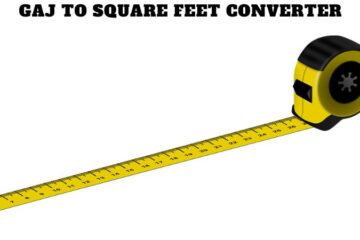The term “1 gaj square feet” can be a bit confusing, as it seems to combine units of measurement. In essence, it refers to an area measurement, but the way it’s expressed is somewhat unconventional. Let’s break down what it signifies and explore its implications.
Gaj as a Unit of Measurement
- Origin: “Gaj” is an ancient Indian unit of length, roughly equivalent to 3 feet or 1 yard. It’s still used in some parts of India and South Asia for informal measurements, particularly in construction and land transactions.
- Variations: The exact value of a “gaj” can vary slightly depending on the region. However, for practical purposes, we can generally consider 1 gaj to be equal to 3 feet.
1 Gaj Square Feet: Deciphering the Term
The phrase “1 gaj square feet” is technically incorrect. Here’s why:
- Square Feet: This represents a unit of area, specifically the area of a square with sides of 1 foot each.
- Gaj: As discussed, this is a unit of length.
Combining “gaj” (a unit of length) with “square feet” (a unit of area) is dimensionally inconsistent. It’s akin to saying “3 feet square meters” – it doesn’t make sense in terms of units.
Possible Interpretations
Given the ambiguity, “1 gaj square feet” might be used to convey a few different meanings:
-
Area of a Square with 1 Gaj Sides:
- This is the most likely interpretation.
- If “1 gaj square feet” is intended to represent the area of a square with sides of 1 gaj (3 feet) each, then the actual area would be:
- 3 feet/gaj * 3 feet/gaj = 9 square feet
-
Area of a Rectangle with One Side of 1 Gaj:
- Another possibility is that it refers to a rectangle with one side measuring 1 gaj (3 feet) and the other side having a length of 1 foot.
- In this case, the area would be:
- 3 feet/gaj * 1 foot = 3 square feet
-
Informal Usage:
- In some cases, “1 gaj square feet” might be used informally to describe a small area, without precise adherence to standard units.
Importance of Clear Communication
The ambiguity surrounding “1 gaj square feet” highlights the importance of using precise and unambiguous language, especially in technical and commercial contexts.
- Construction and Real Estate: Inaccurate measurements can lead to significant errors in construction projects, land surveys, and property transactions.
- Legal and Contractual Matters: Ambiguous terms can create confusion and disputes in legal agreements related to property ownership, leases, and construction contracts.
Practical Implications
- Land Transactions: When dealing with land transactions, always use standardized units of measurement like square meters or square yards to avoid confusion and ensure accurate calculations of land area and property value.
- Construction Projects: Clearly specify all dimensions and areas using standard units to ensure that all parties involved understand the project requirements and avoid costly mistakes.
- Communication: When discussing areas, use clear and unambiguous language to avoid misunderstandings. For example, instead of “1 gaj square feet,” use “a square with sides of 1 gaj” or “a rectangle with dimensions of 1 gaj by 1 foot.”
Conclusion
While “1 gaj square feet” is sometimes used informally, it’s crucial to recognize its inherent ambiguity. By adhering to standardized units of measurement and using clear communication, we can avoid confusion and ensure accuracy in various applications, from construction and real estate to legal and contractual matters.
Frequently Asked Questions (FAQs)
1. What does “1 gaj square feet” actually mean?
Ans. “1 gaj square feet” is an incorrect and ambiguous term. It combines “gaj” (a unit of length) with “square feet” (a unit of area), which is dimensionally inconsistent.
2. What is a “gaj”?
Ans. A “gaj” is an Indian unit of length, roughly equivalent to 3 feet or 1 yard. It’s still used informally in some parts of India and South Asia, particularly in construction and land transactions.
3. How can “1 gaj square feet” be interpreted?
- It might be interpreted as:
- The area of a square with sides of 1 gaj (3 feet) each (9 square feet).
- The area of a rectangle with one side of 1 gaj (3 feet) and the other side of 1 foot (3 square feet).
- An informal way to describe a small area without precise units.
4. Why is “1 gaj square feet” considered incorrect?
Ans. It mixes units of length and area, leading to confusion and potential errors in calculations.
5. What are the implications of using “1 gaj square feet”?
Ans. It can lead to misunderstandings and inaccuracies in construction, real estate transactions, and legal agreements.
6. How can I avoid using “1 gaj square feet”?
Ans. Use standardized units of measurement like square meters or square yards for accurate calculations.
7. What are the consequences of using ambiguous terms like “1 gaj square feet”?
Ans. It can lead to disputes, legal issues, and costly errors in construction projects.
8. Is “1 gaj square feet” ever used correctly?
Ans. It might be used informally in some regions, but its meaning can vary greatly.
9. Why is it important to use standardized units of measurement?
Ans. Standardization promotes consistency, accuracy, and clear communication across different fields.
10. What should I do if I encounter “1 gaj square feet” in a document or conversation?
Ans. Clarify the intended meaning with the person or source to avoid any confusion.


